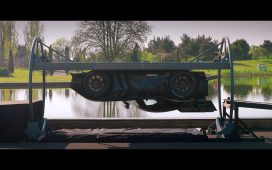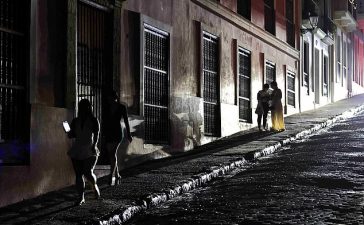
Matthew Sims places a traffic signal for his group’s traffic project presentation at Hazelwood Elementary School on Wednesday, March 29, 2023 in Lynnwood, Washington. (Olivia Vanni / The Herald)
Sonahla Cage was a little nervous to speak in public, even if the audience mostly was her fellow students in Barbara Bromley’s fifth-grade class at Hazelwood Elementary School and a couple of journalists.
Standing at a lectern with a microphone, strangers listening intently can make plenty of people shaky.
After a quiet start, Bromley crouched down in front of Sonahla on a mat with a grid.
In the middle was a set of cardboard pieces erected to represent the school buildings and parking lot, bound on all sides by 28th Avenue W, 204th Street SW, Larch Way and Poplar Way. It wasn’t a perfect scale, since the south side of the campus has dozens of homes and residential dead end roads before Larch Way.
But the mat showed the inflection points of where traffic is worst around the school.
Bromley tasked her students with observing and evaluating traffic immediately around the school, emphasizing the parking lot. The goal was to propose solutions and present them to government officials.
Students got their first chance Thursday with Lynnwood transportation engineer Paul Coffelt.
Initially, the proposals were intended as part of Lynnwood Mayor Christine Frizzell’s challenge to local students. The civic-focused infrastructure projects included Hall Creek and Hall Lake habitat restoration, biking and walking accessibility mapping, sewer outreach and snow response.
Hazelwood Elementary is outside city limits, so Coffelt won’t be able to request or implement any of the proposals after visiting the class Thursday. But a couple of Snohomish County public works staffers were scheduled to hear from students.
With the 3-D model before her, Sonahla’s voice rose along with her comfort and confidence as she explained her idea: Replace the four-way stop at 28th Avenue W and 204th Street SW with traffic signals.
Those lights would improve the safety of students and others crossing the road to and from school. It also was necessary for the second part of her proposal: relocating the student drop-off and pick-up area from the school’s parking to the nearby former site of Alderwood Middle School, which currently doesn’t host students.
Bromley’s students, some in groups and some on their own, proposed nine different projects. Their ideas included new crosswalks, sidewalks, signs, speed bumps and traffic signals along 204th Street SW, a busy road with a 35 mph speed limit and a 20 mph school zone.
All came from experience getting to and from school and watching video of traffic around morning drop-off and afternoon pick-up times. They also watched digital traffic simulations of vehicle movement in and out of the parking lot, thanks to help from a Unity software engineer.
Those simulations “showed a lot of traffic,” student Chenming Guo said during a rehearsal presentation Wednesday.
Rylee Chen, Willow Massruha and Matthew Sims made a paper bridge to illustrate their proposal for an elevated crossing over 204th Street SW near where a bus stops. That way people could cross the road without conflicting with drivers. To help manage traffic, they also had traffic meters similar to the “one car per green” lights near some highway on-ramps.
Atticus Labor and Chase Landis think a crosswalk near the parking lot entrance would make for a safer crossing. They said lots of people jaywalk instead of going to the intersections at 28th Avenue W or Poplar Way. Adding a “do not enter” sign at the parking lot exit could help deter drivers from turning in the wrong way, and on the back of that sign they’d add “consider walking” to encourage people to ditch their cars.
Nuhamin Wondifraw proposed making 204th Street SW a one-way road between 28th and Poplar during drop-off and pick-up times. That way, no one would turn left into the parking lot, which can cause backups in both directions, Nuhamin said.
Other students pitched pedestrian-crossing, speed-limit and speed-feedback radar signs.
“You’ve noticed a problem that is here at your school,” Coffelt said. “You’ve studied it and proposed solutions.”
Coffelt said the students’ ideas were on the right track but needed further evaluation and consideration of how one change can impact traffic elsewhere.
The traffic signal at 28th and 204th, for example, was a good idea to help clear a queue of cars at once instead of every driver stopping at the current four-way stop sign intersection. Adding a crosswalk signal also secures time for people to go across but can eat away at the available green-light time for drivers, Coffelt said.
One thing got Coffelt’s stamp of approval, even if he can’t actually approve the work: sidewalks near schools.
Have a question? Call 425-339-3037 or email streetsmarts@heraldnet.com. Please include your first and last name and city of residence.
Gallery














